 |
| Renda preparing to unload fuel for Nome. |
Examine Question: What are the primary communication systems in Alaska today?
The two most commonly used are the postal system and telecommunications. Each has evolved and developed over time. Each can be considered a work in progress and as technology advances, the economy fluctuates, and politics stays politics, it is unlikely that the work will ever be considered finished.
 |
| Chicken Alaska Post Office |
 |
| AKORN Cable Alaska Communications Systems Group, Inc. |
Telecommunications also has a diverse history in Alaska. From the telegraph to telephone to radio to television and satellite communications, Alaska has attempted to keep up with the rest of the country. (AT&T Alaska offers a timeline of communications in Alaska that puts things in perspective.) Again, the vastness of the state has presented some pretty daunting obstacles. However, Alaska being the state of ingenuity and resourcefulness has been up for the challenge. As depicted in the graphic, Alaska Communications Systems (ACS) has finished the Alaska Oregon Network(AKORN) cable project. This new submarine cable starts at Anchorage, Alaska and ends at Florence, Oregon.
Extend Question: How adequate are the systems in your region of the state?
 Considering that most of the Kenai Peninsula is on the road system, communications here are in pretty good shape. As is shown in the graphic to the left, cell phone service is quite comprehensive, even though from first hand experience there are MANY dead spots. Also, even as I write this, my son is watching cable TV. (I must admit that the little bit of March Madness that I have been able to watch was nice to be seen live.)
Considering that most of the Kenai Peninsula is on the road system, communications here are in pretty good shape. As is shown in the graphic to the left, cell phone service is quite comprehensive, even though from first hand experience there are MANY dead spots. Also, even as I write this, my son is watching cable TV. (I must admit that the little bit of March Madness that I have been able to watch was nice to be seen live.)Down the street from where I live is a large post office. Another personal glitch in communications occurred when my wife and daughter tried to send my son and I a care package that got destroyed and then was returned to sender. However, the rest of our mail has arrived unscathed and I will attempt to not hold the loss of the package against the post office even though it contained homemade cookies.
Three Blog Reviews:
Alaskan History: A Newcomers Perspective
Claire raised some interesting points about the responsibility that comes from exploitation of resources. Salmon and steelhead resources on the Idaho/Oregon border were lost due to the leap before you look philosophy of hydroelectric generation on the Snake River.
Diane is exploring Alaska
Diane made two statements that really connected with me. The first was you were right when you said "Because economic barriers stall the building of roads and railroads, people like Carl Ben Eilsen took on the challenge of bring aviation to Alaska. Bless his heart!" I felt the same way. The other thing was that even though we think that we are pretty secure, Alaska is not yet a priority for icebreakers.
Learn Alaska or Bust
Chris stated that some Alaskans already feel that too many tax dollars are already being spent on rural areas of the state. It certainly makes one think. However, some from the lower 48 might think the same way about Alaska as a whole.
Evaluate:
| Map of IRLP nodes in South Central Alaska |
No comments:
Post a Comment